Jul 26, 2014 | CCAC, commentary, medals, silver
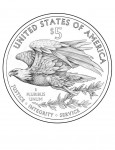
Proposed reverse for the 2015 Ultra High Relief gold coin
These are fair criticisms. I did not attend the April meeting and Chairman Marks provided good introductory explanations prior to the discussion. Before commenting, I should have looked at the previous meeting’s notes which are available on the CCAC website. In retrospect, my criticism about the program was probably not fair. However, it is fair to question the direction the CCAC is proposing.
The other criticism that I will alter but not retract is the one when I said there was an “over-the-top cult-like patriotic gushing by some of the members over the proceedings.” Rather, what I should have said is that the CCAC was very full of themselves to the point of being too self-congratulatory and overblowing the self-perceived importance of what is being proposed.
What is being proposed is a medals program that Marks tentatively called an “American Liberty Silver Medal Program.” The purpose would be for the U.S. Mint to produce modern images of Liberty in medal form. Medals produced under this program would be dated silver proof medals on similar one-ounce planchets that are used for the American Silver Eagle program.
A second program would be a “freestyle medal of an American theme.” The U.S. Mint would solicit ideas from their artist/engravers to be reviewed by the CCAC. One freestyle medal would be produced each year. As part of the proposal, it was suggested that the medals also be produced in bronze to make them more accessible to the average collector.
What is important is that these are proposals for medals and not coins. Medals can be made of any metal and be dated but they will not bear a denomination and would not be legal tender.
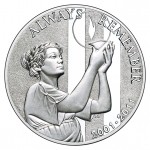
2011 9/11 National Medal (obverse)
What prevented the sales of the September 11 National Medal? It cannot be the design because most people believe it is one of the best medals ever to be produced by the U.S. Mint. Could it be the price? The medal was priced at $66 with a $10 premium to be paid to the museum. This was $10 more than price for the proof American Silver Eagle coin.
Although the September 11 National Medal was a beautiful work of art the price was not too out of line for a silver medal, the fact that it was a medal and not a coin most likely prevented it from being purchased in greater numbers. Even though a commemorative coin will not enter circulation, there may be a psychological barrier from a medal being accepted by collectors because it is not a legal tender coin.
I did not purchase one of these medals. Even though $10 would go to the museum, I opted to write a check as a donation rather than pay for the medal. Even though I like the design, the medal is not something I feel is right for my collection. In writing a check I was also able to use the donation as a charitable tax deduction, which I would not be allowed to do if I purchased the medal. I also do not have this piece of metal that might not resell with a numismatic premium when it comes time to divest my collection.
Reflecting on the meeting and the proposal, those that I corresponded with and I expressed a lot of skepticism that this program would be a success. Regardless of how beautiful the artwork, many believe these medals will not be as popular with the public as portrayed by the CCAC during the meeting.
In fact, if you listened to what members of the CCAC said, you would think that these medals would be the best thing to come out of the U.S. Mint since President Theodore Roosevelt’s “pet crime.” While I really do not want to assail Gary Marks, his remarks at the end of the meeting exemplify this extreme self-ingratiation:
I believe that this is the single most impactful idea that the mint can pursue at this point in time in the United States. With a medals programs such as this, finally, we can have the freedom to have the art come forward. Finally, liberty will be liberated
The committee is energized.
Overall, the CCAC was overly self-congratulatory for doing something that will arguably have the least impact on the collecting community. It was these types of statements from the members of the CCAC that prompted my comments on Tuesday.
Images courtesy of the U.S. Mint.
Jul 11, 2014 | ancient, coins, commentary, policy
During a time where disinformation is a product of hyper-partisanship, it is difficult to write about issues without feeding into the conspiracy theories of the day. The problem with conspiracy theories is that there are so many moving parts and so many people who would have to cooperate that when you really think about their content beyond the headline, you understand how difficult it would be for conspiracies to exist on the scale many suggest.
Conspiracy theories are not a new phenomenon. What is new is how fast they can spread and how the extremes on both side of the aisle can see the same circumstances are come up with radically different conclusions.
Rather than talk about conspiracies, we should look at the issues as more of the result of unintended consequences.
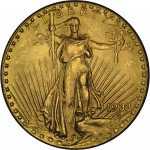
1933 Saint Gaudens Double Eagle is an example of the Law of Unintended Consequences.
For collectors of ancient coins, it is difficult to ignore the law of unintended consequences of Cultural Property Implementation Act (CPIA; 19 U.S.C. §§ 2601 et seq.) and how it is implementation by the State Department’’s Cultural Property Advisory Committee (CPAC). CPIA is the law that was created when the United States signed and the Senate approved the Convention on the Means of Prohibiting and Preventing the Illicit Import, Export and Transfer of Ownership of Cultural Property 1970, often called the 1970 UNESCO Convention. The purpose of the treaty was to stop archaeological pillaging and trafficking in cultural property. In real terms, it would prevent the filling of the British Museum in London with the artifacts from ancient Egypt, Greece, the Middle East, North Africa, and any other place where the British tried to maintain their empire.

EID·MAR Silver Coin commemorating the death of Cæsar on March 15
Although this may sound reasonable, Article 1 paragraph (e) of the treaty defines a category of cultural property as “antiquities more than one hundred years old, such as inscriptions, coins and engraved seals.” This means that any coin minted before 1914 can be considered cultural property and not only be subject to restrictions but confiscated if it cannot be proven that it was found or purchased legally prior to the convention.
With the different rules and laws around the world that has different documentation requirements that were more lax prior to the convention, how does the collector of ancient coins prove the coin that was bought in good faith from a dealer or another collector is not a country’s cultural property? A coin that could have changed hands hundreds of times since it arrived in the United States and enjoyed by its collectors may have had its more modern provenance lost to time and be subject to confiscation by the State Department and returned to the country of origin.
Although the CPAC tries to make the Memoranda of Understanding between the foreign country and the United States simple, the law and convention has a number of problems that have not been addressed in the 40 years it has been in existence. One problem is the existence of ancient Roman coins all over Europe. While the coins were minted in Rome, they were carried throughout the empire by the military, business people, and travelers that were eventually left behind. Since the coins were struck in Rome does it mean that the coins are the property of Italy or the country where they were found? If they country where they were found follows the convention to its letter, since the coins were not manufactured there are they really cultural objects and subject to these export and trade restrictions?
While those of us in the United States have been captivated by the Saddle Ridge Hoard of gold coins, people in the United Kingdom have been buying metal detectors in record number to scour the countryside looking for ancient coins left behind by their ancestors. Recently, someone found four coins dating back to the Iron Age that sparked an archeological search. The find included Roman coins that were not made in England or the land that would become England. Are these British artifacts?
As an aside, British law allows the finders to keep the coins. But since the full archeological search was managed by a British university in conjunction with the military, subsequent finds are the property of the crown since both are paid using public tax money. However, based on the wording of the 1970 UNESCO Convention, does Italy have a claim if they want to pursue those coins?
 Recently, the CPAC held an open meeting to hear the new Egyptian government’s request to ban the import of artifacts dating through the time of the Ottoman Empire. Based on reporting by Richard Gierdroyc in Numismatic News, the questioning of the committee and the answers by those representing the archeological community not only would not grant an exemption for coins but would consider the confiscation of coins that could not be proven to have been legally purchased prior to the 1970 UNESCO Convention and have since fairly traded.
Recently, the CPAC held an open meeting to hear the new Egyptian government’s request to ban the import of artifacts dating through the time of the Ottoman Empire. Based on reporting by Richard Gierdroyc in Numismatic News, the questioning of the committee and the answers by those representing the archeological community not only would not grant an exemption for coins but would consider the confiscation of coins that could not be proven to have been legally purchased prior to the 1970 UNESCO Convention and have since fairly traded.
There is a very vocal crowd in the archeological community that would want to see everything dug up from the earth put into museums or otherwise locked away from the public. (Links to these people omitted on purpose) Using the pejorative “coinys” to describe collectors of ancient coins, these people have advocated for the confiscation of these coin so that they can be entombed behind display glass inside the state run museums of the world. They consider coinys profiteers who would rather trade in history than preserve history.
Collecting, in all of its forms, is a preservation of history. Whether you collect coins, stamps, political campaign buttons, old car emblems, license plates, old kitchen objects, books, toys, postcards, letters, and other ephemera, these items would be lost to time if people did not save them. Owning history helps connect us to our past and even helps us understand how the world has evolved.
History must be preserved and every country has the right to protect the property within its borders. If Egypt wants to protect its property and any future property that archeologists discover, then that should be their right. However, if Egypt wants to restrict United States collectors of coins or other artifacts that have been in circulation for many years, it is suggested that they end their hypocrisy by preying on the “we must do right by the world” policies of the United States and demand that the British Museum to return its holdings.
Jun 21, 2014 | coin design, coins, commemorative, commentary, gold, policy, US Mint
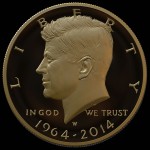
U.S. Mint mock-up of the 24 karat gold 50th anniversary Kennedy half dollar
It has been an ongoing theme written on this blog, the latest was about the nonsensical $1 Trillion coin, is that all you have to do to understand what the U.S. Mint can and cannot do is clearly documented in Title 31, Section 5112 of the United States Code (31 U.S.C. § 5112), Denominations, specifications, and design of coins.
You can read Section 5112 without having to obtain a law degree. It is very readable. It is the section that covers all of the specification for every coin struck by the Mint. It describes the size, weight, content, and the design of the coin. Very little is left up to the Mint in coinage design. But as the U.S. Mint is run by fallible humans, these laws were written by even more fallible humans: congress. This means that some of the laws are very clear while others are open to some interpretation.
First, it has been questioned whether the U.S. Mint can strike more 2014 National Baseball Hall of Fame commemorative coins since they sold out of the gold and silver coins. The answer to that question can be found in law (31 U.S.C. § 5112(m)). This is the section that describes the legal requirements for commemorative coins. Paragraph (2)(B) (31 U.S.C. § 5112(m)(2)(B)) says (emphasis mine):
If the Secretary determines, based on independent, market-based research conducted by a designated recipient organization of a commemorative coin program, that the mintage levels described in subparagraph (A) are not adequate to meet public demand for that commemorative coin, the Secretary may waive one or more of the requirements of subparagraph (A) with respect to that commemorative coin program.
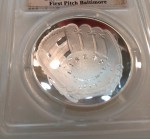
2014 National Baseball Hall of Fame commemorative silver dollars and gold commemoratives are sold out at the U.S. Mint.
As was the case with the 2005 Marine Corps Commemorative Silver Dollar, a quick sellout of the coins does satisfy the evidence necessary for the Secretary to make the decision to increase the production limits. In 2005, then Secretary of the Treasury John W. Snow authorized the U.S. Mint to produce 100,000 additional silver dollars. This was the last commemorative program sellout prior to the Hall of Fame coins.
However, the proposal to increase the production of the National Baseball Hall of Fame coins is speculation. This rumor has not been acknowledged by the U.S. Mint or the Department of the Treasury.
The other claim is that it is illegal or questionable that the U.S. Mint can produce the 2014 Kennedy Half Dollar gold coin. In an op-ed printed in Coin World, William T. Gibbs wrote, “The Mint is using what it cites as existing authority to produce a .9999 fine gold half dollar struck at the West Point Mint, with a 1964–2014 dual date and the higher relief 1964 portrait. The logic behind this coin is hard to understand. We’ve never had a gold half dollar before and the Mint’s legal authority to issue it is open to debate.”
Equating the fact that the U.S. Mint has never produced a gold half dollar coin is a parochial discussion and not whether the U.S. Mint can legally produce the coin. After all, the U.S. Mint produces quarter dollars made of five ounces of silver.

Congress makes the laws and they can change at almost any time!
The same questions were raised when the U.S. Mint issued the 2009 Ultra High Relief Double Eagle Gold Coin. The coin was based on the 1907 design by Augustus Saint-Gaudens was produced in .9999 fine gold and was issued under the Gold Bullion Coins provision of the law (31 U.S.C. § 5112(q)).
Gibbs further says, “When the Mint struck gold versions of the 2000 Sacagawea dollar and announced plans to sell them to the public, Congress stopped the Mint, stating that Mint officials lacked constitutional authority to issue the dollar coin in gold” as an additional argument against the U.S. Mint producing the Kennedy gold coin. In 2000, the law authorizing the U.S. Mint to strike 24-karat coins did not exit. The Buffalo Gold Bullion coin program that the decision is based was signed into law on December 22, 2005 as part of the Presidential $1 Coin Act of 2005 (Public Law 109–145 [PDF]).
The U.S. Mint may not be the most perfect agency and you may not like their decisions, but to accuse them of questionable legal practices is a bit naive.
Jun 6, 2014 | celebration, commemorative, commentary, foreign, history
Operation Overlord was the largest amphibious invasion in history.
Originally scheduled on May 1, it was rescheduled to June 5 and then June 6 because of weather.
Commanded by Gen. Dwight D. Eisenhower, the invading force consisted of 156,000 Allied troops using 5,000 ships and landing craft bringing on shore 50,000 vehicles with overhead support from 11,000 planes and 13,000 paratroopers.
Across 50 miles of Normandy coast line, the United States forces were assigned Utah and Omaha beaches, the British Army was assigned to Gold and Sword beaches, and the Canadian Army invaded Juno beach.
Operation Bodyguard created six decoy invasions as a distraction to the Germans so as to divert their attention from the intended invasion at Normandy. Gen. George S. Patton, considered the most skillful tank commander in U.S. military history, commanded a fake mission to invade Pas-De-Calais.
Omaha Beach was the focus of the attack because it was the most heavily defended beach.
On the first day, 4,414 Allied soldiers were confirmed dead.
Victory was declared on July 21, 1944 when the Allied forces captured Caen, one of the major objectives of the invasion.
The Normandy American Cemetery in Colleville-Sur-Mer is the final resting place for 9,387 Americans. Across its 172.5 acres sits 9,238 crosses and 149 Stars of David where 41 sets of brothers and 3 Medal of Honor recipients rest. The Walls of the Missing is engraved with the names of 1,557 soldiers missing in action.
On this, the 70th Anniversary of D-Day, the day Operation Overlord began, there is one more statistic that should not exist:
The number of commemorative coins issued by the United States to honor those that served and gave their lives to help begin the liberation of Europe from the worst criminal of all time: ZERO!
Although the U.S. Mint did issue a World War II 50th Anniversary commemorative coin in 1995, this country should honor those who participated in the largest amphibious invasion in history and set the world on a safer course.
With the number of veterans of that day dwindling as they are all nonagenarians, I would like to thank them for their service and the families of the fallen for their service. I only wish that congress would realize that their bickering over nonsense with flags on their lapels pales in comparison to the sacrifices made on that day in France. They just do not get it.
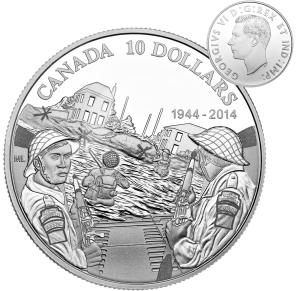
Canadian $10 Commemorative of the 70th Anniversary of D-Day featuring the obverse portrait of King George VI, the reigning monarch at the time of the invasion.
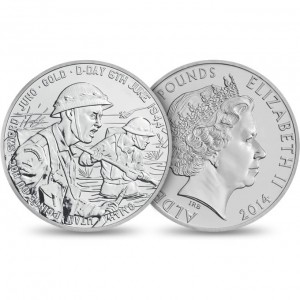
70th Anniversary of D-Day 2014 Alderney £5 BU Coin from the Royal Mint.
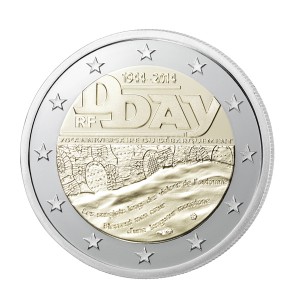
Bimetallic 2 € commemorative issue from the Monnaie de Paris (Paris Mint)
May 26, 2014 | celebration, commentary, history, medals, US Mint
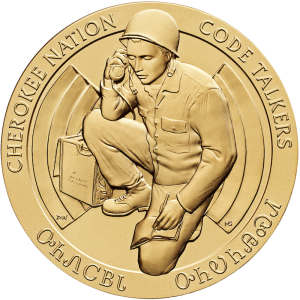
Cherokee Nation Code Talkers Medal
The next year, southern states began their own Memorial Days to honor their soldiers who died during the war. No specific date was used but occurred in late April through June. By 1880, there was a more organized Confederate Memorial Day. These celebrations honored specific soldiers to commemorate the Confederate “Lost Cause.” By 1913, a sense of nationalism saw a commemoration of all soldiers that have died in battle.
In the north, the fraternal organization of Civil War veterans The Grand Army of the Republic began organizing “Decoration Day” in 1868. Decoration Day was to honor the fallen by decorating the graves of Union soldiers with flowers and flags. Ceremonies included speeches that were a mix of religion, nationalism, and a rehash of history in vitriolic terms against the Southern soldiers. The acrimony against the South began to subside by the end of the 1870s.
Memorial Day did not take on national significances until after World War I. Rather than being a holiday to remember those of died in service during the Civil War, the nation began to recognize all those who gave the ultimate sacrifice during all conflicts. By the end of World War II, most of the celebrations were renamed from Decoration Day to Memorial Day. Memorial Day did not become an official holiday until 1967 and its date changed from the traditional May 30 to the last Monday of the month by the Uniform Holidays Act (Public Law 90-363, 5 U.S.C. § 6103(a)) in 1968.
Regardless of how you view the current world conflicts, the men and women who serve in our military deserve the honor and respect for their service. Pray for their ability to safely return home.
We will resume numismatic writings shortly.
Apr 30, 2014 | ANA, commentary, technology, web
“I can’t wait to see what a disaster the ANA new web site will be.”

Laura Sperber
I am not taking the statement out of context. It is the first sentence of the paragraph that appears in her Hot Topics blog post at the Legend Numismatics website.
Prior to this statement, I tried to give Sperber the benefit of the doubt. I greatly respect what she has accomplished in a male-dominated industry. I also appreciate her fight against coin doctoring and shining a light on the problems with coin doctoring and the grading services because I think it has made a positive impact. Unfortunately, her statement appears to be like throwing a tantrum for the sake of being right and not getting it right.
There is a difference between having an opinion and arguing to be right rather than investigating the opinion to getting it right. If Sperber was interested in getting it right, she would speak with those working on the project from the ANA headquarters to see what they are doing. If Sperber was interested in getting it right, as a member of the Board of the Governors she could ask to see the contract, project plan, and records of the costs. If Sperber was interested in getting it right, she could have asked the chairman of the Technology Committee for a meeting with the committee members, who are ANA members and professionals in the computing industry, for a frank discussion on the project.
In fact, Sperber could have asked to talk with me at the Whitman Baltimore Expo where Legend Numismatics always has a prominent table. I attended the show on both Friday and Saturday providing ample opportunity to meet and discuss her concerns.
“There is no way anyone can justify the price paid.”
Other than throwing verbal stones at Board meetings or in her blog, Sperber has not reached out to anyone to make sure she gets it right. Not only is the price in line with industry standards but the team working on the project at the ANA’s headquarters have really worked to keep the costs down and prevent overruns. As a long-time critic of the ANA’s technical acumen, Executive Director Kim Kiick and her team has done a phenomenal job.
Sperber may be a good numismatics business person but she is not knowledgeable in the business of technology to understand how foolish she sounds.
“I know I have a far more reaching and complicated new web site that cost me MUCH LESS to build at LM Auctions.”
With all due respect, no you do not. Buying auction and shopping services off the shelf is not difficult or complicated. What is difficult and complicated is choosing amongst the dozens of vendors to provide the service. If you do an Internet search for “create an auction site” you will find the list of vendors and instruction as to how to go about doing this. If you have the technical background, you can build the site yourself using any of these services. Otherwise, there are plenty of people who can be hired to do the work for you.
In creating Legend-Morphy, Sperber and her business partners purchased technology for the auction services from Sebae Data Solutions of Ocala, Florida. Sebae may not be the company that did their integration, but it appears the Legend-Morphy site was built on top of Sebae’s Bidopia auction platform.
How complicated could creating an auction website for this company be when her partner, Dan Morphy Auctions, uses Sebae’s services to manage their auctions? Morphy Auctions is well known and respected in the antique collectibles business, thus it would make sense that if they were to branch out into other areas, they would use proven technologies they are familiar with.
The use of Sebae’s software and services is not a problem. What is a problem is Sperber’s misrepresentation of what it takes to build storefront and auction site. The difficult part is to create an experience to entice customers to bid and buy. From what I can see, the company they hired to integrate these services did a good job for what they did, but it is not complicated.
In comparison, the new ANA web presence is not about selling goods and services. The new ANA web presence is about education. It is about providing an experience to welcome people to enjoy numismatics on all levels. The new web presence has to be able to integrate the business of the ANA including processing membership requests, bring the library closer to the members, allow those from the web experience the exhibits of the Money Museum, deliver education, provide a forum for numismatists to meet virtually, facilitate virtual attendance of shows, and possibly be able to allow people to participate in live events such as the Money Talks sessions at the ANA shows.
If you want to compare what the ANA is trying to do with its website versus having a site that is a numismatic catalog such as the one Sperber thinks is so complicated, go to the website of any college or university and look at the content offered. Those sites offer online classes, registration, recruitment, information about seminars, and information about activities including athletics.
Unlike an auction or retail website, there is no commercial off the shelf (COTS) software to support the functions the ANA or any educational-based organization could buy. Rather, the ANA and the colleges have to buy services and pay to have them integrated. In this case, the ANA is buying the membership services and backend processing but it has to be integrated to support the ANA mission. The ANA will be buying other services that can be used to support the ANA mission, but you need something to bring those services to the membership and public.
Think about your car. The automobile manufacturer may buy parts to build an engine but it does not manufacture those parts. They will buy the door assembly because it is cheaper for them to hire a dedicated company to run the electronics or buy the seats that are built to their specification. But when it is all delivered, the automobile manufacturer integrates the parts into the one unit that appears on the showroom floor.
It is the same analogy in the website building business. Legend-Morphy’s business model allows them to choose one vendor with a few selected products that can be integrated without a lot of work as compared to the ANA’s model that has to provide very diverse services that cannot be purchased in one place but still has to be built to look like one product.
Based on my previous conversations with Sperber, I believe she has been in the business of numismatics as long as I have been in the computer and technology business. I respect her passion, knowledge, and accomplishments for what she has done in her career. But when she makes her pronouncements that the Legend-Morphy website is “a far more reaching and complicated new web site” when those of us who know better, then not only does she come off as foolish, but she proves that she is out of her league when it comes to assessing technology.
This initiative was started by then ANA President Tom Hallenbeck. Hallenbeck understood that the Board and the ANA headquarters were not technically savvy enough to do this without help, so he formed the Technology Committee consisting of members who are professionals in all aspects of technology. Current ANA President Walt Ostromecki, who will jokingly be the first to tell you he might be less technically aware than Hallenbeck, was insistent on keeping this committee together to ensure the success of the site.
When this started, the committee Chairman James Reinders reached out to me knowing that I was a staunch critic of the lack of technology used by the ANA. It was also clear that my background in building systems and computer security would be a benefit to this effort. Sure, they were hesitant in contacting me because I had not been exactly complementary to the ANA (examples are here and here).
This was essentially a put-up-or-shut-up opportunity. I could sit in front of my computer and kvetch or I could be part of the solution. I hope my input to the committee, headquarters staff, and Board has been helpful because as a member I am trying to do what is best for the organization.
Laura Sperber is no longer an outsider. Sperber is directly inside as an elected member of the ANA Board of Governors. She has access to the same information about this project as I do. However, she has chosen to throw verbal and written rocks at the issue in an attempt to be right rather than get it right.
Therefore, I challenge Governor Sperber to put down her verbal rocks and get it right. I challenge her to reach out to the ANA headquarters, the Technology Committee, and even participate in our weekly status teleconference to learn about the project. If she is serious about representing the best interest of the ANA as an elected member of the Board of Governors then this is the opportunity to learn about the project.
Apr 10, 2014 | coins, commemorative, commentary, legislative, policy, US Mint
 Amongst all of the noise on Capitol Hill, the one area where no noise has been made is in the numismatic arena. For the last three months there has been no bill introduced, heard in committee, or acted on by either chamber of congress. Although there have been some hearings on a few issues, the last numismatic-related bill that had any congressional action was the introduction of the Pro Football Hall of Fame Commemorative Coin Act, S. 1842, introduced by Sen. Rob Portman (R-OH) in December.
Amongst all of the noise on Capitol Hill, the one area where no noise has been made is in the numismatic arena. For the last three months there has been no bill introduced, heard in committee, or acted on by either chamber of congress. Although there have been some hearings on a few issues, the last numismatic-related bill that had any congressional action was the introduction of the Pro Football Hall of Fame Commemorative Coin Act, S. 1842, introduced by Sen. Rob Portman (R-OH) in December.
This type of inactivity is unusual for congress. Regardless of party, congress is always looking to curry favor with their constituents and groups associated with their constituents by introducing commemorative coin legislation. Over the last few congresses (a two-year term), there will be over 40 coin-related bills that die in committee where very few even get a cursory hearing.
This does not mean there will be no commemorative coins in the near future. Now, the U.S. Mint has issued the Civil Rights Act of 1964 Silver Dollar and National Baseball Hall of Fame commemoratives. In fact, the Baseball Hall of Fame coins are so popular that the gold option has sold out of its 50,000 statutory mintage limit.
As an aside, a friend pointed out that the U.S. Mint did not bring 50,000 gold coins to the Whitman Baltimore Expo and wondered how many of those coins were purchased by baseball’s owners and members of the Baseball Hall of Fame. It would be interesting to see the effect of organized baseball on the sale of these coins.
In 2015, the U.S. Mint is scheduled to release a March of Dimes Commemorative Silver Dollar commemorative coin. Founded in 1938 by President Franklin D. Roosevelt to combat polio, the March of Dimes changed its mission to combating birth defects after the discovery of the polio vaccine by Dr. Jonas Salk in 1954. Salk’s work was supported by the organization.
Also on the schedule for 2015 is the United States Marshals Service 225th Anniversary commemorative coin series. The Marshal Service commemoratives will include a gold $5, silver dollar, and clad half-dollar coins. I do not think this will be as popular as the 2005 Marine Corps 30th Anniversary commemorative coins.
Officially, the 2016 scheduled commemorative will be the Mark Twain Commemorative coin program that will only include gold $5 and silver dollar coins. However, considering Twain’s mindset about being famous, I think he would be amused by having a commemorative coin made in his honor. I might call it the “Mark Twain Amusement commemorative.”
The only other commemorative coin with legislation that has passed congress and signed by the president is the 2017 Lions Clubs International Century of Service Silver Dollar.
Given the law says that there will be no more than two commemorative coin series per year (31 U.S.C. §5112(m)); and given that the next time only one commemorative coin is scheduled to be issues is in 2016, there is plenty of time for congress to do “something” and pass one of the bills that is currently waiting for their action.
Mar 21, 2014 | coins, commentary, eBay, legal
 The Ninth Circuit Court of Appeals upheld the dismissal of the antitrust class action suit against eBay for its policy for listing certified coins for sale.
The Ninth Circuit Court of Appeals upheld the dismissal of the antitrust class action suit against eBay for its policy for listing certified coins for sale.
The story begins in 2007 when eBay began to set standards for listing coins on its site. As part of its decision as to which coins could be listed as graded with their grade as part of the listing, the policy was created that grading services had to have been rated good or better in the 2006 Grading Services Survey performed by Professional Numismatic Guild and Industry Council for Tangible Assets.
After a lot of protest from the numismatic community, by 2008, eBay changed their policy for listing coins to require coins worth more than $2,500 to be graded and listings that mention grades be graded by an approved grading service. To become an approved grading service the company has had to grade 50,000 pre-1956 coins, provides an online population report, has three professional graders on staff with at least one a member of the Professional Numismatic Guild, provide a written guarantee, encase coins in a tamper resistant holder with anti-counterfeiting measures, and provide an online serial number verification service.
Initially, only coins graded by Numismatic Guarantee Corporation and Professional Coin Grading Service qualified under these rules. Shortly before the ruling was to take effect, ANACS and Independent Coin Graders make the necessary adjustments to have coins in their holders qualify for listing as graded on eBay.
Universal Grading Service (UGS) was a nascent New Jersey-based grading service decided to file an antitrust suit eBay, the American Numismatic Association, then ANA President Barry Stuppler, and PNG claiming that the rules are preventing them from competing in the market. Their claim was that coins in their holders were allegedly banned by eBay claiming that by using the study, eBay was in collusion with the ANA and PNG to prevent them from participating in the market, an alleged violation of the Sherman Antitrust Act.
UGS initially filed the anti-trust case in the Eastern District of New York. The court, based in Brooklyn, determined that since eBay was the lead defendant and the service most impacted by the suit, New York was not the proper jurisdiction. The court ordered that the case be transferred to Northern District of California.
The case was move to the San Jose Division for the Northern District of California and assigned to Judge Ronald M. Whyte. In mid-2011, Judge Whyte granted motions (with prejudice) to dismiss the case against the ANA, PNG, and Barry Stuppler. That left only eBay as the lone defendant.
On January 9, 2012, Judge Whyte granted eBay’s motion to dismiss the case with prejudice. Judge Whyte noted that the case was flawed from the beginning and gave UGS every opportunity over two years to amend the case in order to prove their claim. Judge Whyte agreed with eBay that USG did not provide evidence that eBay violated the Sherman Antitrust Act or other associated laws.
UGS appealed to the Ninth Circuit Court of Appeals saying that Judge Whyte wrongly dismissed the claim and that they met their filing responsibility under the Sherman Antitrust Act and associated state laws. The three judge panel affirmed the Judge Whyte ruled properly and let the dismissal stand.
UGS, who has ceased operations, can appeal the case to the full Ninth Circuit asking for a review. When appealing a ruling to a full circuit court panel, all nine judges assigned to that circuit, including the members of the three-judge appellate panel, will hear the appeal. An attorney familiar with Federal Circuit Courts said that it is rare that a dismissal by a federal district judge that is upheld by an appeals panel will be selected to be heard by the full circuit. He did note that stranger things have come out of the Ninth Circuit and it could be possible that they would hear the case.
After the Ninth Circuit, the next step would the Supreme Court. Sources report that if the full Ninth Circuit refuses to hear the case or the dismissal is upheld, “there is no attorney in his right mind” that would file an appeal to the Supreme Court after two courts uphold a dismissal.
With this ruling, the Universal Grading Service is effectively dead and buried. Whatever the people behind UGS were hoping to get out of this case will not be realized.
One thing this ruling says is that the cost to entry the coin grading market is very high. The court affirmed that eBay can set the market rules and as one of the dominating venues for selling coins, a new grading service would have to meet eBay’s requirements in order to gain market acceptance. The difficult benchmark is to have graded 50,000 pre-1956 coins.
There appears no reason why pre-1956 was picked as the dividing line. For many, it would make sense to select pre-1965 to include all coins that are pre-clad coinage. Calls to eBay to obtain clarification about the policy have not been returned. Since eBay consulted with John Albanese, principal of Numismatic Consumer Alliance and Certified Acceptance Corporation (CAC), contacting him may be an option.
Interestingly, if eBay is to follow its policy to the letter, coins that received verification stickers from the CAC cannot be listed as part of the grade. Titles should not be allowed to indicate that the coins have been verified by CAC nor should the description. As far as I am concerned it would be acceptable for eBay to ban the designation of CAC verification as I am not a fan of the service.
Which raises a thought: considering the CAC’s business model includes only coins certified by NGC and PCGS, and given Albanese’s past associations with both of those services, if the case was limited to eBay and Albanese/CAC would it have been more successful?
Mar 15, 2014 | ANA, commentary, technology
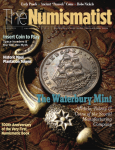
March 2014 edition.
Once you open your copy, you might want to check out the article on page 67. It is written by your favorite numismatic blogger talking about the work being done by the ANA and the Technology Committee on the new ANA website.
Please read the article, but I want to reiterate two points:
- The technology committee is made up of ANA members who are volunteering their time and expertise to ensure that everything regarding the building of the website is in the best interest of the ANA. Long time readers know that aside from my background in information security, I had been a critic of how the ANA was technologically unsophisticated. They benefit by bringing in members, especially those of us who have been critical, to help them move forward in a way to best benefit the organization.
- The work being done by the ANA staff in Colorado Springs has been tremendous. First, it was a great idea by then Executive Director Jeff Shevlin to hire (the now defunct) Amos Digital to really kick start the process. Amos Digital did an excellent job helping the ANA manage the request for proposal (RFP) process and coordinating the review and selection process. It is unfortunate that Amos Press disbanded Amos Digital because they had a great team.
Since becoming Executive Director, Kim Kiick has really done a wonderful job in working with the Board, the Tech Committee, and the selected vendor. In fact, Kim and her staff has worked so well with the new vendor that they have found additional cost savings while maintaining the standards we techies want to ensure is maintained throughout this process.
Writing an article for The Numismatist is more difficult than a blog post because of space limitations. There is only so much that can be said in a limited amount of space. Since I do not have those limitations here, I want to take the opportunity to praise the work of the one person who has really done a tremendous job for the ANA.
For those who do not know, Jake Sherlock is the magician behind the scenes making the cobbled together technology work in trying to make the ANA appear technologically friendly. From helping to maintain the website whose software is sorely out of date to figuring out how to broadcast meetings from the ANA convention, Jake has worked hard with very little to do a lot for the association.
What makes this even more awe inspiring is that Jake does not have a technical background. I am sure he will correct me, but I think he told me his background is in communications and public relations. He should be commended by everyone associated with the ANA for stepping into this role and making a big difference.
Once the new technology is in place it will be fun to see what Jake can do with modern tools.
Thank you, Jake!
Feb 13, 2014 | Australia, coin design, coins, commentary, nclt
Whenever I comment on using design elements on coins that do not involve engraving I am reminded that one person’s gimmick is another’s innovation. I am also reminded that I have demonstrated a bit of hypocrisy by purchasing some of these coins for my collection including celebrating the innovation of one of these coins. So why do I have a near visceral reaction to the introduction of a coin whose purpose is to commemorate with a non-engraved design elements?
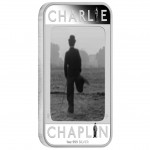
2014 Charlie Chaplin 1 oz lenticular commemorative coin from the Perth Mint
The reverse does not use just any image. It is the iconic image of the waddling tramp walking away from the camera. Like the image on the screen, this is a moving image. Using lenticular technology, the image will shift as you move the coin making it appear that Chaplin is walking.
Chaplin was the nascent movie industry’s first megastar. Although Mary Pickford and Douglas Fairbanks were the most recognizable of the time, Chaplin was the first actor whose movies were considered a success because he was involved with them. And while there were posters and booklets printed about other stars, Chaplin was the first to be fully merchandised around the world including a Chaplin doll that is one of the most prized toy and movie memorabilia collectibles today.
Even though Chaplin was the phenomenon of this time and I consider myself a fan, I am having a difficult time liking this coin.
In fact, I downright hate it!
I cannot explain why I hate this coin because I am interested in the Niue 2007 Van Gogh silver coin and the Andorra 2008 Renoir 10 Diners silver coin. All three coins are colored coins and ingot shaped, but the Chaplin coin really bothers me.
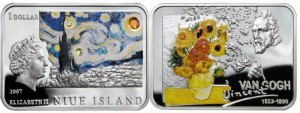
Niue Island 2007 Great Painters – Vincent Van Gogh $1 Rectangular Silver Dollar with Color and Zircon Crystal Gemstones
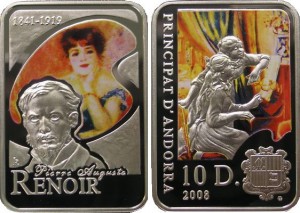
Andorra 2008 Great Painters – Pierre August Renoir 10 Diners Rectangular Silver Proof with Color
Although I did not like the Monnaie de Paris 2012 Yves Klein commemorative coin with the blue hand, I did not have this type of reaction. However, I still like the 2006 Canadian Breast Cancer commemorative and circulating quarter with enameled features.
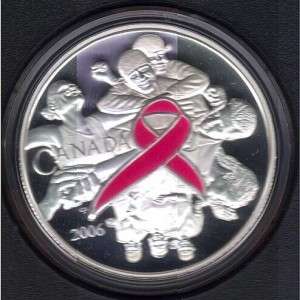
2006 Breast Cancer Silver Coin with colored pink ribbon.
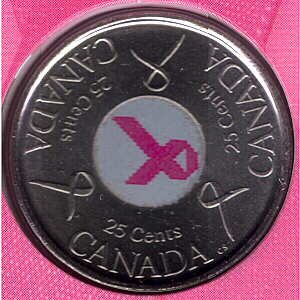
2006 Breast Cancer Quarter was Canada’s first colored circulating coin
One of the differences between the colored coins that I like versus those that I do not are the ones I like do have some engraving involved. And even though I do not like the Yves Klein commemorative, I do not find it as objectionable because the blue hand is an enhancement and not the entire design on the coin.
Not counting the Somalia motorcycle and sports car coins, I seem to have this response where the coloring or design gimmick encompasses the entire design of the coin. Once the coloring or other design elements that are not engraved go beyond enhancements and are used to create the design is when I begin to object.
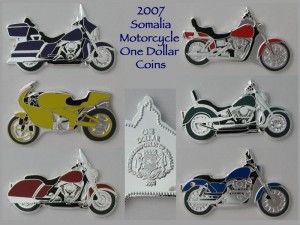
2007 Somalia Motorcycle Non-circulating Legal Tender Coins

2010 Somalia Sports Cars
It could also be the subject matter. As a resurgent gear-head with an eye toward the classics, the Somalia classic motorcycles and sports car coins appeal to me while the coins with colored birds and flowers do not. As the surviving spouse of a cancer victim, I supported the use of coins to raise money for cancer research by the Royal Canadian Mint, but none of the current hologram coins would interest me if they did not have the holograms.
Color and other enhancements on coins are here to stay. If there were not a market for them then the various mints would not produce these types of coins. It may be something that will attract more collectors and grow the hobby, which is good.
Maybe I should think about these enhancements like I think about cars: I want a car that drives and feels like a car and a coin that is engraved art; I do not want to drive a computer nor a coin that seems gimmicky.
Credits
- Image of the 2014 Charlie Chaplin 1-ounce lenticular silver coin courtesy of the Perth Mint.
- Images of the Van Gogh and Renoir coins courtesy of Talisman Coins.














 The
The 







